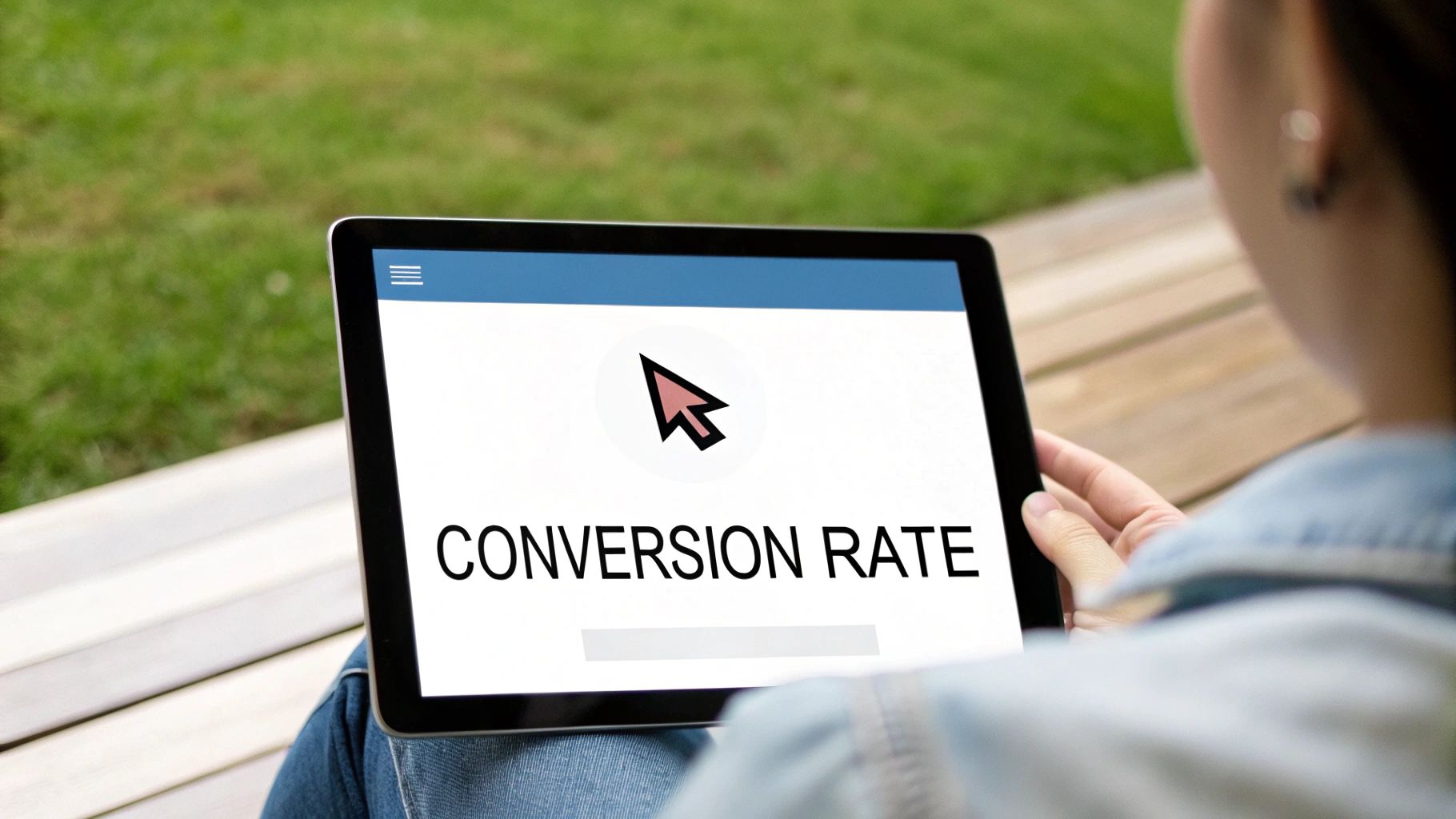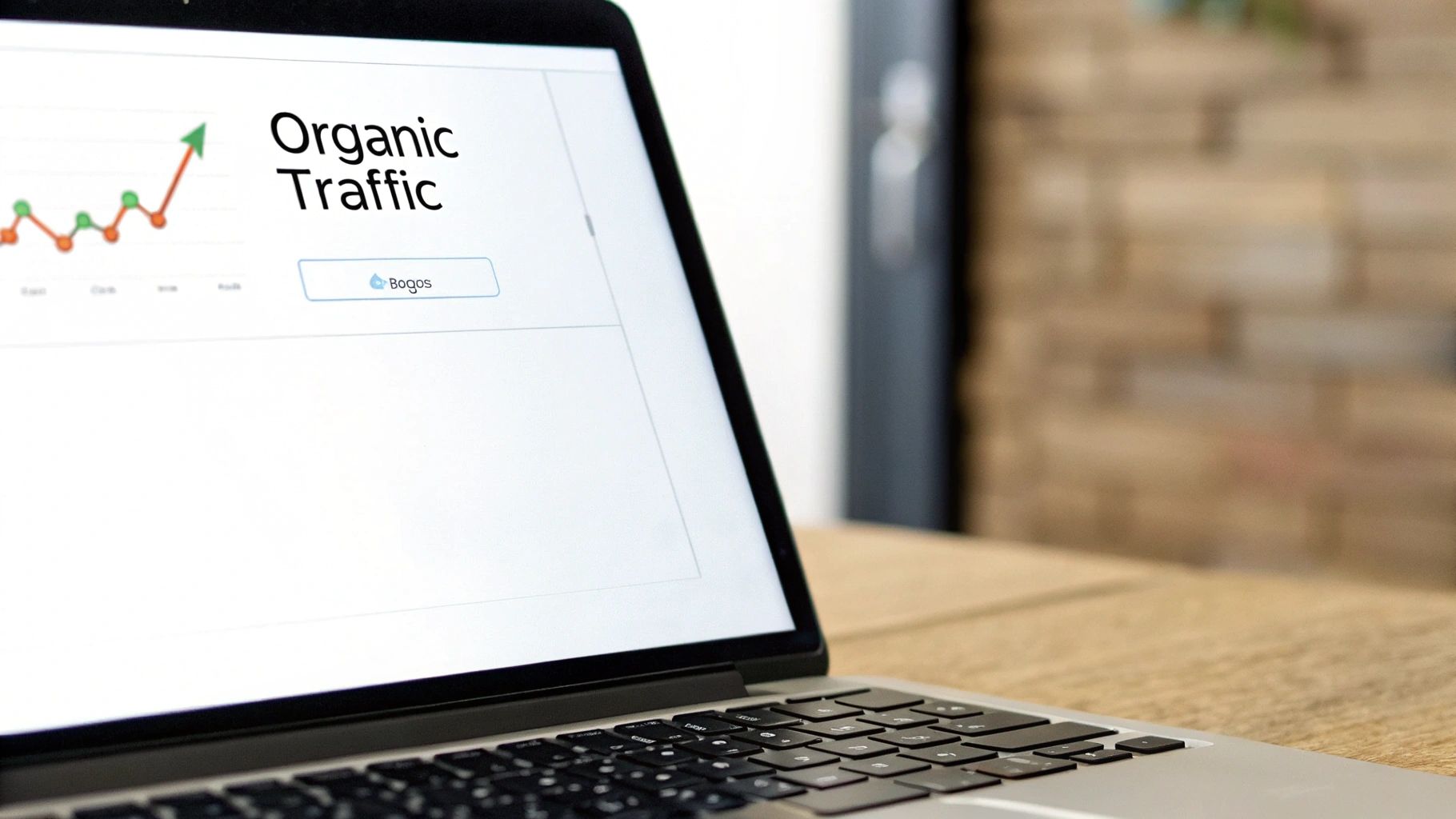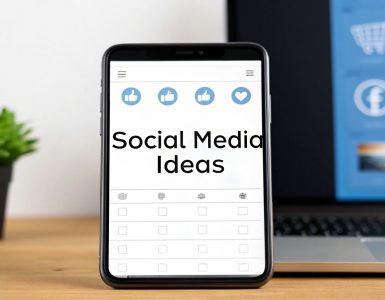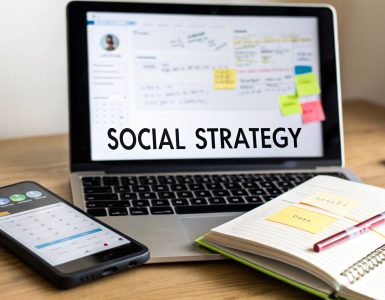In a data-driven world, tracking content performance is non-negotiable. But with countless data points available, it's easy to get lost in a sea of vanity metrics that don't reflect actual business impact. Effective content marketing isn't just about getting eyes on your content; it's about driving tangible business results, from brand awareness and audience engagement to lead generation and revenue. The key is knowing which content marketing metrics to focus on to prove value and refine your approach.
This guide breaks down the 10 most critical metrics that will help you prove your content's ROI, optimize your strategy for maximum impact, and make smarter decisions. We'll explore what each metric means, why it matters, how to calculate it, and, crucially, how to turn these numbers into actionable insights using tools like EvergreenFeed.
For instance, while high page views are great, pairing that data with Time on Page and Conversion Rate tells a much richer story about content quality and audience intent. By focusing on this curated set of key performance indicators (KPIs), you can move beyond surface-level analysis and start connecting your content efforts directly to the bottom line. This article will provide the formulas, benchmarks, and best practices you need to measure what truly matters. We will cover everything from traffic and engagement to ROI and customer retention, giving you a complete framework for assessing your content's success. Let's dive into the metrics that will transform your content strategy from a guessing game into a predictable growth engine.
1. Traffic / Page Views
Traffic, often measured in page views, is one of the most fundamental content marketing metrics. This metric counts the total number of times a specific page on your website has been viewed by users. It provides a direct measure of your content's reach and visibility, acting as a foundational data point to gauge initial interest and awareness. A high number of page views suggests your content is successfully attracting an audience through channels like search, social media, or email.

While simple, it's a powerful indicator of top-of-funnel success. For example, the HubSpot blog analyzes page views to identify which educational articles generate the most interest, helping them double down on topics that resonate. Similarly, SEO expert Neil Patel monitors traffic spikes to understand which keywords and content formats are currently driving the most engagement from his target audience.
How to Leverage Traffic Data
Merely tracking volume isn't enough; the key is to understand the context behind the numbers. High traffic with low engagement can signal a problem with your content's quality or relevance.
- Set Channel-Specific Goals: Establish traffic targets for different content types (e.g., blog posts, landing pages) and track your progress monthly. This helps you understand which formats are most effective at drawing visitors.
- Track Your Sources: Use UTM parameters in your URLs to precisely identify which channels (social media, email campaigns, organic search) are driving the most traffic. This insight is crucial for allocating your marketing budget effectively.
- Analyze Traffic Quality: Compare page views against conversion rates. A high-traffic, low-conversion page may be attracting the wrong audience, whereas a lower-traffic page that converts well is bringing in qualified leads.
Pro Tip: Cross-reference page views with metrics like bounce rate and time on page. A high page view count paired with a low bounce rate and high time on page indicates that visitors are not just arriving, but are genuinely engaged with what they find. This combination is a strong signal of high-quality, valuable content.
2. Engagement Rate
Engagement rate is a critical content marketing metric that measures how actively your audience interacts with your content. It goes beyond simple views to track meaningful actions like comments, shares, and likes, offering a clear indication of how resonant and valuable your content is. A high engagement rate signals that your content is not just being seen, but is actively sparking a connection with your audience.
This metric is a direct measure of content quality and audience alignment. For example, Buffer reports that their social media posts containing questions achieve 23% higher engagement rates, proving that interactive formats drive participation. Similarly, HubSpot found that blog posts featuring videos see 80% higher engagement than text-only articles, highlighting the power of multimedia to capture and hold audience attention.
How to Leverage Engagement Data
Tracking engagement isn't just about celebrating high numbers; it’s about understanding what makes your audience tick. High traffic with low engagement can indicate a disconnect between your content's promise and its delivery.
- Ask Direct Questions: Incorporate clear, thought-provoking questions into your content to encourage comments and start a conversation. This simple tactic invites your audience to participate directly.
- Monitor Topic Performance: Analyze which content types and topics consistently generate the most interaction. Use this data to inform your future content calendar, focusing on formats that have proven to be successful.
- Encourage Specific Actions: Use clear calls-to-action (CTAs) that guide users toward a desired interaction, such as "Share your thoughts in the comments below" or "Tag a colleague who would find this useful."
Pro Tip: Don't just track engagement; participate in it. Responding promptly and thoughtfully to comments shows your audience that you value their input, which can foster a loyal community and encourage even more interaction over time. This turns passive viewers into active brand advocates. Learn more about social media engagement metrics on evergreenfeed.com.
3. Click-Through Rate (CTR)
Click-Through Rate (CTR) is a critical content marketing metric that measures the percentage of users who click on a specific link, call-to-action (CTA), or ad after viewing it. This metric directly evaluates the effectiveness of your headlines, email subject lines, and ad copy in compelling an audience to take the next step. A high CTR indicates that your messaging is resonant, relevant, and persuasive enough to capture immediate interest.
CTR is a core performance indicator for email marketers and paid media specialists. While average email CTR hovers around 2.5%, highly personalized campaigns can often exceed 5% or more. Similarly, SEO expert Neil Patel famously found that headlines incorporating numbers can achieve a 36% higher CTR than those without, demonstrating how small tweaks can yield significant performance gains.
How to Leverage CTR Data
A high CTR is a strong signal of audience engagement, but it must be analyzed in context. For instance, a high CTR on a social media post that leads to a page with a high bounce rate suggests a disconnect between your content's promise and its delivery.
- A/B Test Your Elements: Continuously test different headline styles, CTA button colors, and ad copy to identify what resonates most with your audience. Even minor changes in wording can dramatically impact performance.
- Segment and Analyze: Track CTR by channel (e.g., email, organic search, social media) to understand where your most engaged audience is coming from. A high CTR from a specific email segment might indicate a topic worth exploring further.
- Optimize for Intent: Use action-oriented and benefit-driven language in your CTAs, such as "Download Your Free Guide" instead of a generic "Click Here." Ensure the copy aligns with the user's intent at that stage of their journey.
Pro Tip: Pair CTR analysis with conversion rates. A high CTR with a low conversion rate might mean your CTA is effective at getting the click, but the landing page isn't delivering on its promise. This combination helps you pinpoint weaknesses in your conversion funnel beyond the initial click.
4. Conversion Rate
Conversion Rate is one of the most critical content marketing metrics because it directly measures the percentage of users who complete a desired action after interacting with your content. This action could be a purchase, a form submission, a download, or a newsletter signup. It’s the metric that connects your content creation efforts directly to tangible business outcomes and demonstrates return on investment (ROI).

This metric is a cornerstone for growth marketing professionals and has been popularized by conversion rate optimization (CRO) platforms like Optimizely. For example, a B2B SaaS company might find that a detailed case study converts 2.23% of its readers into qualified leads, while an e-commerce brand might see a 2.63% average conversion rate from blog posts that showcase product uses. Research also shows that landing pages with video can see conversion rates up to 80% higher than those without, proving the impact of content format on action.
How to Leverage Conversion Rate Data
Tracking conversions reveals which content effectively persuades your audience to take the next step. High traffic with a low conversion rate suggests a disconnect between your content's promise and its ability to motivate action.
- Segment by Source and Content: Analyze conversion rates for different traffic sources (organic, social, paid) and content types (blog posts, webinars, guides). This helps you identify your most profitable channels and formats.
- Optimize for Intent: Ensure your content offer and call-to-action (CTA) align with the user's stage in the buyer's journey. Top-of-funnel content should aim for micro-conversions like a newsletter signup, while bottom-funnel content should drive demo requests or purchases.
- A/B Test and Refine: Continuously test elements like headlines, CTA copy, and landing page design. For instance, testing a first-person CTA like "Get My Free Guide" can improve conversions by up to 90% compared to more generic phrasing.
Pro Tip: Don't just focus on macro-conversions (e.g., sales). Track micro-conversions like video views, PDF downloads, or shares for your top-of-funnel content. These smaller actions are leading indicators of engagement and can help you nurture prospects toward a final purchase decision.
5. Return on Investment (ROI)
Return on Investment (ROI) is the ultimate bottom-line content marketing metric. It measures the profitability of your content efforts by comparing the financial gain against the total cost of investment. This metric moves beyond engagement and reach to provide a clear, quantifiable answer to the question: Is our content generating real business value? A positive ROI proves that your content is not just an expense but a revenue-driving asset.
Calculating ROI is crucial for justifying marketing budgets and securing executive buy-in. For instance, HubSpot famously reported that their content marketing ROI improved by 100% after implementing structured attribution, demonstrating a direct link between content and revenue. Similarly, many B2B companies that invest in strategic blogging see an ROI of 4:1 or higher within just six months, proving the long-term value of consistent content creation.
How to Leverage ROI Data
Tracking ROI accurately requires meticulous record-keeping and a focus on both costs and returns. It helps you prioritize high-performing content and optimize underperforming assets.
- Track All Costs: Meticulously log all expenses related to content, including team salaries, freelance fees, software tools, and paid promotion costs. This forms the "Investment" part of your calculation.
- Use Multi-Touch Attribution: Go beyond last-click attribution. Use a multi-touch model to understand how different content pieces contribute to a conversion along the customer journey. This provides a more accurate picture of content's true impact.
- Calculate by Content Type: Determine the ROI for different formats like blog posts, videos, and ebooks. This reveals which types of content deliver the best financial returns, allowing you to allocate resources more effectively. For a deeper dive into this, you can learn more about comprehensive content marketing measurement.
Pro Tip: When calculating ROI, factor in the long-term Customer Lifetime Value (CLV) rather than just the initial purchase value. Content often builds relationships that lead to repeat business, and including CLV provides a far more accurate representation of your content's total financial impact.
6. Time on Page / Average Session Duration
Time on Page and Average Session Duration are critical content marketing metrics for gauging user engagement and content quality. Time on page measures how long a user spends on a single page, while average session duration tracks the total time a visitor spends on your site during a single visit. Both metrics provide powerful insights into how captivating and relevant your content is, directly impacting user experience and SEO performance.
High values for these metrics signal that your content successfully holds the reader's attention. For instance, data from Medium shows its most successful blog posts, which keep readers engaged for 2-3 minutes on average, are typically between 1,500 and 2,500 words. Similarly, HubSpot discovered that pages with an average session duration exceeding five minutes often correlate with higher search engine rankings, as Google interprets this as a sign of high-quality, valuable content.
How to Leverage Engagement Time Data
Tracking these metrics helps you move beyond simple reach to understand true content resonance. A high bounce rate combined with low time on page often indicates a mismatch between what your headline promises and what your content delivers.
- Create In-Depth Content: Develop comprehensive articles, guides, or case studies that justify longer reading times. Long-form content (3,000+ words) can achieve an average time on page of 4-6 minutes if it provides deep, actionable value.
- Improve Readability and Flow: Use subheadings, bullet points, short paragraphs, and multimedia elements like images and videos to break up text. This encourages scrolling and keeps users engaged for longer periods.
- Promote Further Exploration: Strategically place internal links to related articles throughout your content. This encourages visitors to explore more pages, which directly increases the average session duration.
Pro Tip: Analyze time on page for different sections of your content using scroll-depth tracking tools. This can help you identify specific paragraphs or elements where users lose interest and drop off, allowing you to optimize those low-engagement areas for better retention.
7. Social Shares, Backlinks, Brand Awareness & Reach
This group of content marketing metrics measures your content's authority, amplification, and overall market presence. Social shares track how often your content is shared across platforms, backlinks count incoming links from other websites, and brand awareness gauges your visibility. Together, they reveal your content's ability to generate organic reach and build a strong reputation. High numbers here indicate your content is not just consumed, but valued enough to be endorsed and distributed by others.
These metrics showcase long-term brand building. For instance, BuzzFeed’s viral content strategy frequently results in articles earning over 50,000 social shares, massively amplifying their reach. In the SEO world, Moz famously found that first-page Google results average 77 backlinks, proving their value as a ranking signal. Similarly, Drift, a conversational marketing platform, increased its brand share of voice by 42% in just one year through targeted content that generated both shares and valuable backlinks.
How to Leverage This Data
Simply counting shares and links isn’t enough; the goal is to understand how they contribute to brand authority and market penetration. High engagement on social media and a growing backlink profile are leading indicators of successful, high-impact content.
- Create Inherently Shareable Content: Focus on creating assets that provide clear, immediate value. Original research, comprehensive guides, statistical roundups, and practical templates are highly shareable and attract backlinks naturally.
- Make Sharing Effortless: Add prominent social share buttons to all your content pieces. You can even provide pre-written social media copy to remove friction and encourage visitors to share your work with a single click.
- Track Brand Mentions and Search Volume: Use tools to monitor unlinked brand mentions and track the search volume for your brand name over time. A consistent increase is a strong sign that your content is successfully boosting brand awareness.
Pro Tip: Combine your content promotion with strategic outreach. Build genuine relationships with industry journalists, bloggers, and influencers. Promoting your best content to these relevant figures can significantly amplify its reach and help you acquire authoritative backlinks that boost your SEO performance.
8. Lead Generation & Cost Per Lead (CPL)
Lead generation is one of the most vital content marketing metrics for businesses focused on growth. It measures the number of potential customers, or leads, captured through your content via actions like email signups, form submissions, or demo requests. Complementing this is Cost Per Lead (CPL), which calculates the average expense to acquire one lead by dividing your total content marketing spend by the number of leads generated. Together, these metrics directly connect your content efforts to pipeline and revenue.
This dual-metric approach is heavily championed by marketing automation platforms like HubSpot and Marketo, which use lead capture as a core function. For example, a B2B SaaS company might find its webinars generate high-quality leads at a CPL of $75, while its downloadable e-books bring in a higher volume of leads at a lower CPL of just $20. By analyzing both volume and cost, they can build a balanced strategy that fills the top of the funnel efficiently while also nurturing high-intent prospects.
How to Leverage Lead Generation Data
Simply generating leads is only the first step; optimizing for both quantity and quality at an efficient cost is the goal. A low CPL is meaningless if the leads never convert into customers.
- Gate Your High-Value Content: Place premium assets like in-depth reports, whitepapers, or webinar recordings behind a simple form to capture contact information from interested prospects.
- Optimize Your Landing Pages: Create dedicated, distraction-free landing pages for each lead magnet. A/B test headlines, calls-to-action (CTAs), and form fields to maximize completion rates and lower your CPL.
- Implement Lead Scoring: Assign points to leads based on their actions (e.g., pages visited, content downloaded) and demographic data. This helps you prioritize follow-up and identify sales-ready prospects for a smoother handoff.
Pro Tip: Track CPL by content type and distribution channel. You might discover that leads from LinkedIn ads have a higher CPL but a much better conversion rate than leads from organic search. This granular insight allows you to allocate your budget to the channels that deliver the most valuable outcomes, not just the cheapest leads.
9. Search Engine Rankings & Organic Traffic
Search engine rankings and organic traffic are two of the most critical content marketing metrics for long-term growth. Rankings measure your content's position on search engine results pages (SERPs) for specific keywords, while organic traffic counts the visitors who arrive at your site from those unpaid search results. Together, these metrics directly reflect the success of your SEO strategy, your content's visibility, and its ability to generate sustainable, high-intent traffic.

These metrics are powerful because high rankings drive consistent traffic long after content is published. For instance, Brian Dean of Backlinko famously used his "Skyscraper Technique" to create comprehensive content that achieved #1 rankings for highly competitive terms, generating a massive, continuous flow of organic traffic. Since the first page of Google captures over 91% of all clicks, improving your rankings by even a few spots can dramatically increase your reach and authority.
How to Leverage Ranking Data
Tracking your rank is just the first step; the real value comes from using that data to refine your strategy and climb higher. High rankings for irrelevant keywords won't help your business goals.
- Target Long-Tail Keywords: Start by targeting longer, more specific keywords. These have lower competition and attract a more qualified audience, making it easier to rank and drive conversions.
- Optimize for Click-Through Rate (CTR): A high rank doesn't guarantee clicks. Write compelling title tags and meta descriptions that entice users to choose your result over others.
- Build an Internal Linking Structure: Strategically link from your high-authority pages to new or lower-ranking pages. This passes "link equity" and helps search engines discover and index your content more effectively.
- Update and Refresh Content: Search engines favor fresh, relevant information. To learn more about how to measure content performance, review existing high-potential articles every 12 to 18 months, updating statistics, adding new insights, and optimizing for new keyword opportunities.
Pro Tip: Use Google Search Console to find "striking distance" keywords, which are terms where you rank on page two (positions 11-20). Prioritizing these pages with content updates and internal links is often the fastest way to see significant organic traffic gains.
10. Customer Retention Rate & Repeat Engagement
Customer Retention Rate is a critical content marketing metric that measures the percentage of customers who continue to do business with you over a specific period. Paired with repeat engagement, which tracks how often existing customers return to consume your content, it reveals your ability to build lasting loyalty and deliver sustained value beyond the initial purchase. A high retention rate signifies that your content effectively supports and nurtures your customer base, turning one-time buyers into long-term advocates.
This metric is a cornerstone for subscription-based and SaaS companies, where long-term value is paramount. For instance, Slack’s strategic onboarding content is credited with significantly improving month-to-month retention, while Netflix’s personalized content recommendations help it maintain an impressive subscriber retention rate. These examples show how targeted content is not just for acquisition, but is a powerful tool for keeping customers engaged and satisfied.
How to Leverage Retention Data
Tracking retention reveals the health of your customer relationships and the ROI of your post-purchase content strategy. High churn can indicate that your content fails to meet the ongoing needs of your customers.
- Create Lifecycle-Specific Content: Develop content for every stage of the customer journey, from onboarding guides and feature tutorials to advanced use cases and industry insights. This ensures customers continuously find value in your brand.
- Build a Community: Use forums, exclusive webinars, or loyalty programs to foster a sense of community. This encourages repeat engagement as customers return for peer-to-peer interaction and exclusive resources.
- Personalize the Experience: Segment your audience based on behavior and usage data. Deliver personalized content, such as tailored case studies or relevant feature updates, to address their specific needs and challenges.
Pro Tip: Cross-reference your customer retention rate with Net Promoter Score (NPS) and Customer Satisfaction (CSAT) scores. A high retention rate paired with a high NPS indicates you are creating true brand advocates who are not only staying but are also likely to promote your business. This combination is a powerful indicator of sustainable growth.
10 Key Content Marketing Metrics Comparison
| Metric | 🔄 Implementation complexity | ⚡ Resources & speed | 📊 Expected outcomes | 💡 Ideal use cases | ⭐ Key advantages |
|---|---|---|---|---|---|
| Traffic / Page Views | Low — basic analytics setup (Google Analytics) | Low resources; near‑real‑time collection | Volume-based reach/visibility baseline | Compare content popularity; monitor traffic trends | ⭐ Simple to track; shows overall reach |
| Engagement Rate | Medium — aggregate engagements & impressions (platform-specific) | Low–medium resources; real-time on social platforms | Measure audience resonance and interaction | Social posts, community growth, algorithm optimization | ⭐⭐ Good predictor of content relevance |
| Click-Through Rate (CTR) | Low — track clicks vs impressions (UTMs recommended) | Low resources; quick to measure and A/B test | Indicator of headline/CTA effectiveness and traffic potential | Email campaigns, ads, CTAs, search snippets | ⭐⭐ Actionable for optimization; improves traffic |
| Conversion Rate | Medium–High — goal/event setup and attribution | Medium resources; requires testing and sufficient data | Business outcomes (signups, purchases); ROI signal | Landing pages, ecommerce, lead-gen funnels | ⭐⭐ Direct link to revenue; prioritizes optimization |
| Return on Investment (ROI) | High — cost tracking and multi-touch attribution | High resources; long timeframe (6–12+ months) | Financial return vs cost; budget justification | Executive reporting, channel comparison, budget decisions | ⭐⭐⭐ Shows business value; supports investment choices |
| Time on Page / Avg. Session Duration | Low — standard analytics metric, segmentable | Low resources; immediate but needs sample size | Signal of content depth and attention retention | Long-form content, UX and content quality testing | ⭐ Indicates content quality; SEO relevance |
| Social Shares / Backlinks / Brand Reach | Medium–High — multiple tools, qualitative evaluation | Medium–high resources; slow to accumulate impact | Authority, organic amplification, referral traffic | Thought leadership, viral campaigns, linkbuilding | ⭐⭐ Builds authority; boosts organic discoverability |
| Lead Generation & Cost Per Lead (CPL) | Medium — form/CRM integration and tracking | Medium resources; requires spend data for CPL | Number and cost of leads; pipeline input | B2B demand gen, gated content, webinars | ⭐⭐ Ties content to sales pipeline; cost optimization |
| Search Engine Rankings & Organic Traffic | Medium — SEO tools + ongoing optimization | Medium resources; slow to improve (3–6+ months) | Sustainable organic visibility and traffic growth | Evergreen content, long-term SEO strategy | ⭐⭐ Cost-effective long-term traffic; credibility |
| Customer Retention & Repeat Engagement | High — cohort analysis and CRM integration | High resources; long-term measurement | Loyalty, repeat visits, increased LTV | SaaS/subscriptions, customer success, loyalty programs | ⭐⭐⭐ Drives recurring revenue and referrals |
Turn Metrics into Momentum with Smart Automation
Navigating the world of content marketing without clear metrics is like sailing without a compass. You might be moving, but you have no idea if you're heading toward your destination. Throughout this guide, we've dissected the 10 essential content marketing metrics that act as your navigational tools, guiding your strategy from initial awareness to final conversion and long-term loyalty.
From the foundational data of Traffic and Page Views to the critical bottom-line figures of Conversion Rate and ROI, each metric tells a unique part of your content's story. Engagement Rate and Social Shares reveal how well your message resonates, while Time on Page shows if you're truly capturing attention. Meanwhile, tracking Lead Generation, Search Engine Rankings, and Customer Retention Rate provides a complete picture of your content's impact on business growth.
But data, no matter how detailed, is useless without action. The ultimate goal isn't just to measure; it's to build a self-sustaining content engine that consistently drives results. This is where you transition from a reactive analyst to a proactive strategist.
From Measurement to Mastery: Closing the Loop
Understanding your metrics is the first step. The second, more powerful step is creating a system to amplify what works. You’ve identified your top-performing blog posts, the articles that consistently bring in organic traffic, and the resources that generate the most qualified leads. Now, what do you do with them? Letting this proven content get buried in your blog archives is a massive missed opportunity.
This is where intelligent automation transforms your workflow and maximizes your content's lifespan. By systematically resurfacing your best assets, you ensure they continue to deliver value long after their initial publication date.
Key Takeaway: The most successful content marketers don't just create great content; they build systems to ensure that great content is seen again and again. This creates a powerful feedback loop where top-performing pieces continually drive traffic, engagement, and conversions with minimal additional effort.
Building a Sustainable Content Engine
Instead of being trapped in a constant cycle of creation, you can leverage your existing high-performers to maintain a consistent presence. Imagine your best evergreen content, the cornerstone pieces that define your brand's expertise, automatically populating your social media calendar. This approach not only saves hundreds of hours in manual scheduling but also guarantees that your audience is consistently exposed to your most valuable insights.
This strategy hinges on connecting your performance data to your distribution plan.
- Identify Winners: Use metrics like high Time on Page, strong organic traffic, and low bounce rates to pinpoint your evergreen champions.
- Categorize and Organize: Group these assets into thematic buckets (e.g., "Beginner's Guides," "Advanced Tactics," "Case Studies").
- Automate Distribution: Implement a tool that can pull from these buckets to create a varied and valuable social media queue.
By combining rigorous tracking of your content marketing metrics with smart automation, you close the loop on your content strategy. You stop guessing and start building a predictable, scalable system for growth. You turn one-time content creation efforts into long-term assets that work for you around the clock, building momentum that compounds over time. This is how you move from simply producing content to building a true content marketing powerhouse.
Ready to stop your best content from getting lost and put your distribution on autopilot? EvergreenFeed connects directly to your blog and Buffer account, automatically recycling your top-performing posts to keep your social media channels active and your traffic flowing. Start your free trial today and see how easy it is to turn your content metrics into unstoppable momentum.
Get started with EvergreenFeed




